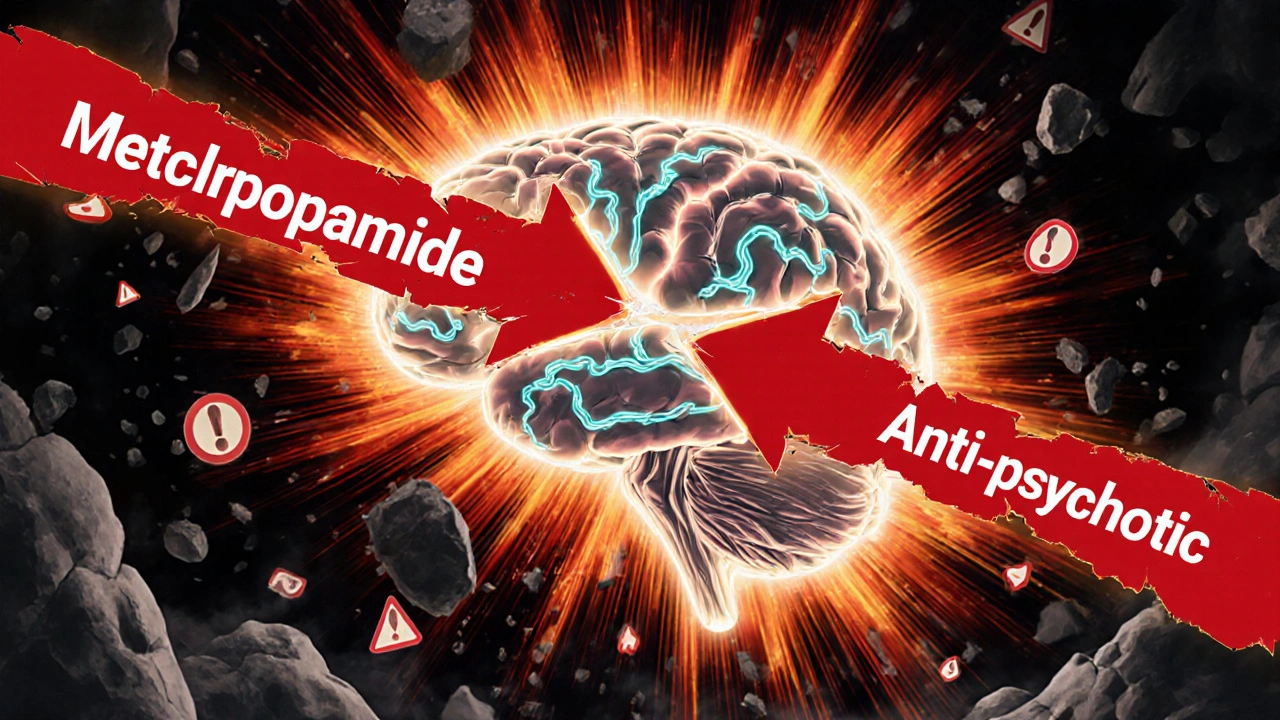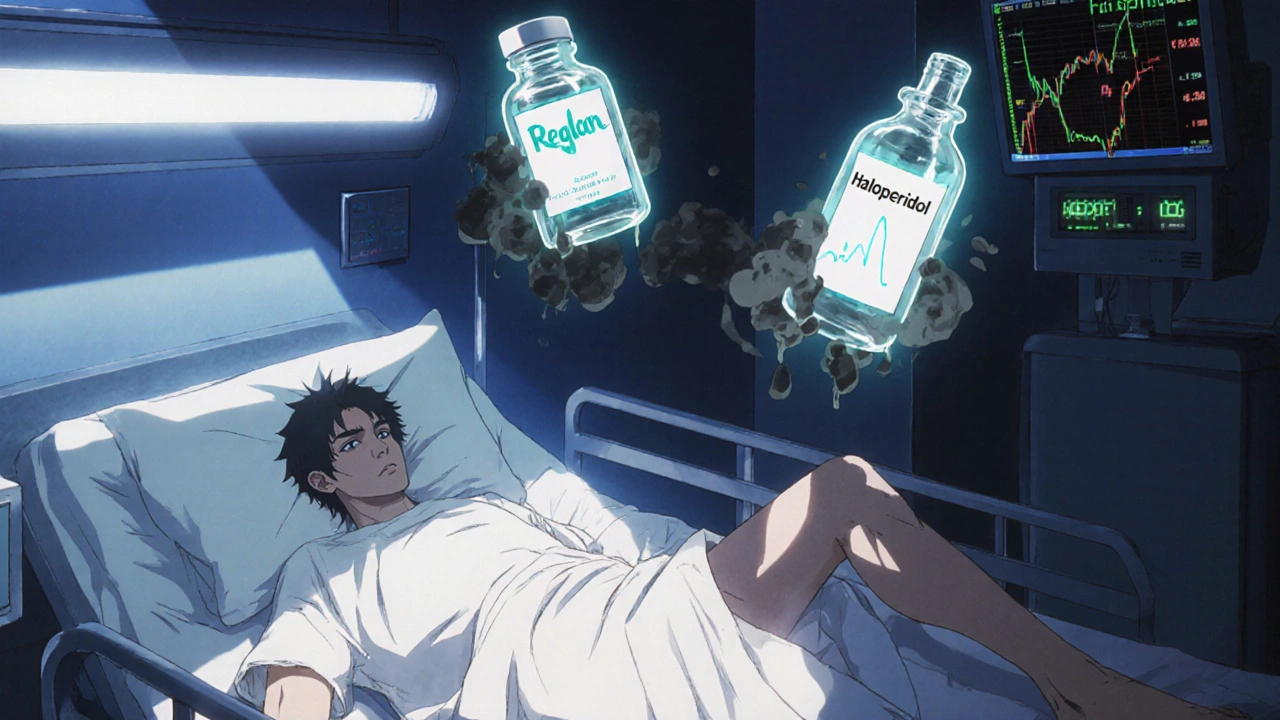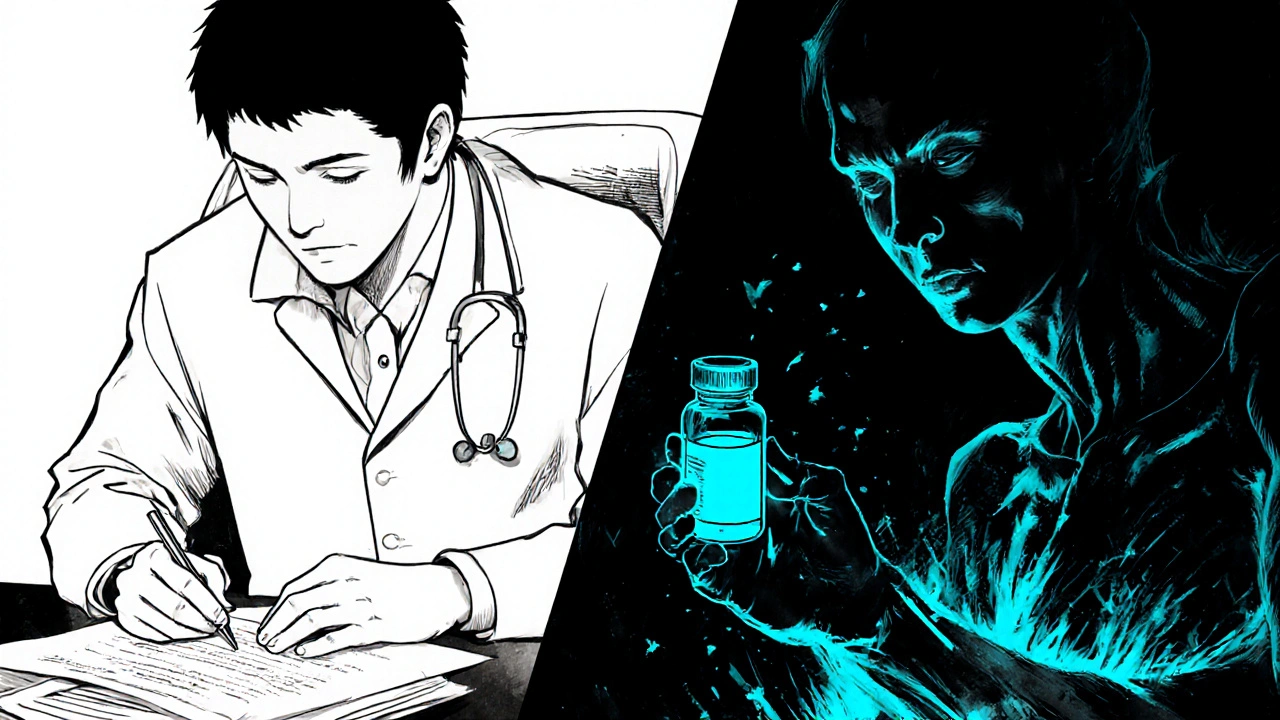Metoclopramide and Antipsychotics: The Hidden Risk of Neuroleptic Malignant Syndrome
 Oct, 27 2025
Oct, 27 2025
NMS Risk Assessment Tool
This tool helps you understand your risk of Neuroleptic Malignant Syndrome (NMS) when taking certain medications together. The interaction between metoclopramide and antipsychotics can be life-threatening.
Risk Assessment
Answer the questions below to determine your risk level.
Risk Assessment Result
Why This Matters:
Neuroleptic Malignant Syndrome (NMS) is a life-threatening condition that can cause fever, muscle rigidity, confusion, and organ failure. It's often fatal if not treated immediately.
Combining metoclopramide with antipsychotic medications isn’t just a mild caution-it’s a medical red flag. The risk isn’t theoretical. It’s documented, regulated, and life-threatening. Neuroleptic Malignant Syndrome (NMS) can develop in hours or days when these two drug classes are used together, and the consequences are often severe-sometimes fatal.
What Exactly Is Neuroleptic Malignant Syndrome?
NMS isn’t just a side effect. It’s a medical emergency. It shows up with four key signs: high fever (often above 102°F), stiff muscles that won’t relax, confusion or loss of awareness, and unstable vital signs-like racing heart, fluctuating blood pressure, or sweating without cause. These symptoms don’t come from a cold or the flu. They come from your brain’s dopamine system shutting down.
Dopamine is the brain’s signal for movement, mood, and body temperature control. When dopamine receptors get blocked too hard, too fast, your body loses its ability to regulate itself. That’s what happens when metoclopramide and antipsychotics are taken together. Both drugs do the same thing: they block dopamine receptors. Together, they don’t just add up-they multiply.
Why Metoclopramide Is a Hidden Danger
Metoclopramide (sold as Reglan, Gimoti) is often prescribed for nausea, vomiting, or slow stomach emptying. Many doctors assume it’s safe because it’s not a psychiatric drug. But that’s the trap. Metoclopramide crosses the blood-brain barrier and acts on dopamine receptors in the brain-just like haloperidol, risperidone, olanzapine, and other antipsychotics.
The FDA’s prescribing label for metoclopramide says it clearly: Avoid Reglan in patients receiving other drugs associated with NMS, including typical and atypical antipsychotics. That’s not a suggestion. That’s a warning stamped in the strongest category possible. And it’s not just the FDA. The NCBI’s StatPearls database calls metoclopramide a known cause of movement disorders, including tardive dyskinesia, and highlights its boxed warning-the most serious type the FDA issues.
Worse, metoclopramide isn’t just dangerous because of what it does. It’s dangerous because of how your body processes it. It’s broken down by an enzyme called CYP2D6. Many antipsychotics-like risperidone, haloperidol, and even some antidepressants like fluoxetine and paroxetine-block this same enzyme. So when you take them together, metoclopramide doesn’t get cleared from your body. It builds up. Higher levels in the blood mean more dopamine blockade in the brain. Two risks, one bottle.
The Double Hit: Pharmacodynamics and Pharmacokinetics
This interaction isn’t just one problem-it’s two layered on top of each other.
First, the pharmacodynamic hit: both drugs block dopamine receptors. The brain can’t compensate. Movement control fails. Temperature regulation fails. Mental clarity fades.
Second, the pharmacokinetic hit: your liver can’t break down metoclopramide fast enough because antipsychotics are clogging the cleanup system. Studies show patients with reduced CYP2D6 activity-either due to genetics or drug interference-have up to three times higher metoclopramide levels in their blood. That’s not a small increase. That’s a dangerous surge.
People with kidney problems are at even greater risk. Metoclopramide is cleared through the kidneys. If kidneys aren’t working well, the drug lingers. Add antipsychotics on top? The risk of NMS jumps dramatically.
Who’s Most at Risk?
This isn’t a random risk. It targets specific groups:
- Patients on long-term antipsychotics, especially older ones like haloperidol
- People with Parkinson’s disease or a history of movement disorders
- Those with kidney impairment
- Patients taking other CYP2D6 inhibitors (fluoxetine, paroxetine, bupropion)
- Anyone taking metoclopramide for more than 12 weeks
And here’s the cruel twist: many of these patients are already vulnerable. Someone with schizophrenia or bipolar disorder might need an antipsychotic to stay stable. But if they develop nausea from the medication-or from a stomach condition-they’re often given metoclopramide without anyone checking the interaction. It’s a silent trap.

What Happens When NMS Starts?
It doesn’t start with a fever. It starts with stiffness. A patient might complain their arms feel tight, or they can’t move their neck. Then comes restlessness, confusion, or sudden sweating. Within hours, the fever climbs. Muscles become rigid like a board. Creatine kinase (CK) levels in the blood spike as muscles break down. If untreated, kidney failure, seizures, or cardiac arrest can follow.
There’s no single test for NMS. Doctors diagnose it by recognizing the pattern: recent drug exposure + fever + rigidity + altered mental status. The key is catching it early. The sooner it’s stopped, the better the chance of survival.
What Should You Do Instead?
If you’re on an antipsychotic and need help with nausea or gastroparesis, metoclopramide is not the answer. There are safer options:
- Ondansetron (Zofran): Blocks serotonin, not dopamine. Safe with antipsychotics.
- Prochlorperazine (Compazine): While also a dopamine blocker, it’s used in lower doses and monitored differently. Still, caution is needed.
- Promethazine (Phenergan): Works on histamine receptors. Lower risk than metoclopramide, but can cause sedation.
- Methylprednisolone or corticosteroids: Sometimes used for gastroparesis in patients who can’t tolerate other drugs.
The best choice? Ondansetron. It’s effective, doesn’t touch dopamine, and has minimal interaction risk with antipsychotics. It’s become the go-to in hospitals and psychiatric units for a reason.
What If You’ve Already Taken Both?
If you’re on both drugs and haven’t had symptoms, don’t panic-but don’t wait either. Talk to your doctor or pharmacist immediately. Ask: Is there a safer alternative? If you’re experiencing any new stiffness, confusion, fever, or unusual sweating, seek emergency care. Don’t wait for it to get worse.
Stopping metoclopramide suddenly is usually safe-unlike antipsychotics, which need careful tapering. But if NMS is suspected, hospitalization is required. Treatment includes stopping both drugs, aggressive cooling, IV fluids, and sometimes medications like dantrolene or bromocriptine to restore dopamine function.

Why This Interaction Is Still Happening
Despite clear warnings, this combo still shows up in prescriptions. Why? Three reasons:
- Many prescribers don’t realize metoclopramide affects the brain the same way antipsychotics do.
- Patients don’t tell their doctors about all the medications they’re taking-especially over-the-counter or older prescriptions.
- Metoclopramide is cheap and widely available. It’s easy to reach for.
The result? A preventable crisis. In 2021, a study in the Journal of Clinical Psychopharmacology found that nearly 12% of NMS cases in psychiatric patients were linked to metoclopramide use-many of them avoidable.
What Patients Should Ask Their Doctor
If you’re on an antipsychotic and your doctor suggests metoclopramide, ask:
- Is this the safest option for my condition?
- Could this interact with my other medications?
- Is there a non-dopamine-blocking alternative?
- What signs should I watch for that mean I need to go to the ER?
And if you’ve had movement problems with metoclopramide before-tremors, twitching, stiffness-tell your doctor. That’s not just a side effect. It’s a warning sign that your brain is already sensitive to dopamine blockade.
The Bottom Line
Metoclopramide and antipsychotics don’t just mix poorly-they create a perfect storm. The risk of NMS is real, rare, but deadly. The FDA says avoid it. The research says avoid it. The clinical experience says avoid it.
There’s no scenario where the benefit of combining these two drugs outweighs the risk. If you need nausea relief while on an antipsychotic, ask for ondansetron. If you have gastroparesis, explore other options. Your brain-and your body-deserve better than a drug combo that could shut them down.
Don’t assume it’s safe because it’s common. Don’t trust that your doctor knows every interaction. Ask. Double-check. Push for safer choices. Because in this case, the safest choice isn’t the cheapest one-it’s the one that doesn’t risk your life.

Jenn Clark
October 28, 2025 AT 16:29I had a friend on risperidone who got prescribed Reglan for nausea and ended up in the ER with a 104°F fever and muscle rigidity. No one connected the dots until it was almost too late. This post saved my life - I asked my psychiatrist to switch me to Zofran last week. Never again.
L Walker
October 29, 2025 AT 07:04Metoclopramide’s a sneaky one. I’m a pharmacist in London and I’ve seen this combo pop up more times than I can count. Doctors think it’s just a ‘stomach pill’ - until the patient starts shaking like a leaf and their CK hits 15,000. FDA warning? Yeah, it’s there. But no one reads the tiny print. Sad.
giri pranata
October 29, 2025 AT 16:38Bro this is so real 😅 I’m from India and my uncle got this combo prescribed for his bipolar + gastroparesis. He ended up in ICU for 10 days. Now I make sure everyone I know checks drug interactions before taking anything. Don’t trust ‘common’ meds - they can kill you. 🙏
Stuart Rolland
October 31, 2025 AT 02:57Let me tell you - this isn’t just about metoclopramide. It’s about how broken our prescribing culture is. We treat medications like they’re candy - pop one for nausea, pop one for psychosis, and never ask if they’re playing musical chairs inside your brain. Dopamine isn’t just a mood chemical - it’s the conductor of your entire motor system. Block it too hard, and your body forgets how to breathe, how to cool down, how to move. And then you’re in the ICU wondering why your legs won’t unclench. We need better education - for doctors, for patients, for pharmacists. This isn’t a rare event - it’s a systemic failure disguised as a ‘side effect.’
Kent Anhari
October 31, 2025 AT 04:21Good post. I work in a psych unit and we’ve banned metoclopramide entirely. Ondansetron is our go-to now. Simple, safe, effective. Why make people risk their lives for a $5 drug when there’s a $15 alternative that doesn’t turn your brain to concrete?
Charlos Thompson
November 1, 2025 AT 10:58Oh wow, so metoclopramide isn’t just a ‘safe’ anti-nausea drug? Shocking. Next you’ll tell me aspirin doesn’t cure cancer. 😏
Peter Feldges
November 3, 2025 AT 04:37It’s fascinating how pharmacokinetic interactions are routinely overlooked in clinical practice. The CYP2D6 inhibition cascade, coupled with pharmacodynamic synergy, creates a non-linear risk profile that exceeds additive effects. The FDA’s boxed warning is not merely advisory - it is a categorical contraindication grounded in robust pharmacovigilance data. Yet, in 2023, we still see this combination in outpatient scripts. This is not negligence - it is institutionalized ignorance.
Richard Kang
November 3, 2025 AT 17:04OMG I JUST TOOK REGLAN LAST WEEK WITH MY ANTIPSYCHOTIC AND NOW I FEEL A LITTLE STIFF??? I’M GONNA DIE??? WHAT DO I DO??? I NEED HELP!!!
Rohit Nair
November 3, 2025 AT 22:57i read this and my hands started shaking... i was on both for 3 months last year. i thought the twitching was just stress. now i know. thank you for writing this. i’m telling my doc tomorrow.
Wendy Stanford
November 4, 2025 AT 10:47It’s not just the drugs - it’s the entire medical industrial complex that reduces human beings to algorithmic inputs. We’ve turned healing into a checklist. Nausea? Check. Antipsychotic? Check. Metoclopramide? Check. No one sees the person behind the diagnosis. The dopamine system isn’t a switch - it’s a symphony. And we’re playing it with a chainsaw. We don’t need more drugs. We need more humility.
Jessica Glass
November 4, 2025 AT 18:53Wow, so you’re saying doctors aren’t perfect? Who knew? Maybe if people stopped being lazy and read their own prescriptions, we wouldn’t have this problem. But no - just blame the system. Classic.
Rachel Harrison
November 6, 2025 AT 12:53Yesss!! I’m a nurse in a psych ward and we switched everyone from Reglan to Zofran 2 years ago. No more NMS scares. 🙌 Also, tell your patients to check their meds on Drugs.com - it’s free and saves lives. 💊❤️
Tiffanie Doyle
November 8, 2025 AT 00:04my aunt got this combo and it was scary as hell but she’s okay now!! thank you for posting this!! i’m sending it to my whole family!! 🤍
james landon
November 8, 2025 AT 12:10So… what’s the real story here? Is this just another fear-mongering post to make people feel bad about taking meds? I mean, people have been on this combo for years. Nothing happened to me.
Lilly Dillon
November 9, 2025 AT 21:22My mom’s on risperidone. I’m printing this out and handing it to her doctor tomorrow. Thanks.